Japan Wood Products
Prices
Dollar Exchange Rates of
29th July 2014
Japan Yen 101.86
Reports From Japan
Inflation target threatened
Recent data from Japan‟s Cabinet Office show that
inflation slowed in June which puts more pressure on the
Bank of Japan (BoJ) which has set itself the target of
raising inflation to break the deflationary cycle that has
blighted Japan for years.
The data show that consumer prices (excluding fresh food)
rose just 3.3% year on year. One of the main issues is that
incomes are not growing causing consumption to slow.
Analysts suggest that most companies have either
absorbed or already passed on the increase in consumption
tax and are not optimistic of any sustained inflation which
could force the BoJ into more monetary easing.
Growth forecast lowered
The Japanese government has lowered its forecast for the
country‟s economic growth in the current fiscal year
which ends in March 2015. The government now projects
that the economy will grow1.2% (revised down from
1.4%) up to March next year.
At the moment the signals are all bad, exports are down,
imports are up, private sector investment has stalled and
retail sales are worse than expected suggesting consumers
have become very cautious and are easing up on spending.
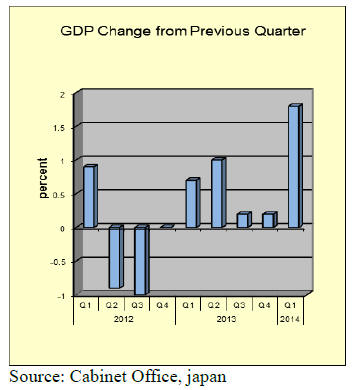
8 million vacant homes
The Japanese Internal Affairs and Communications
Ministry has released the results of its latest survey of
vacant homes showing a record high of 1 in 7 houses
across Japan are vacant and many are derelict and in need
of demolition.
While the average rate of vacant homes may be 14% in
some rural areas over 20% of houses are vacant.
Over the five-year period since the last survey the stock of
vacant homes increased by 630,000 to over 8 million,
there are calls for an urgent response by the central and
local governments to address the problem of rapidly
deteriorating houses which pose safety and health hazards.
June housing starts – better than forecast
June housing starts data from Japan‟s Ministry of Land,
Infrastructure and Transport show that while there was an
improvement over levels in the previous month year-onyear
starts are around 9% down. However, many analysts
had expected worse figures, some in the region of minus
12%.
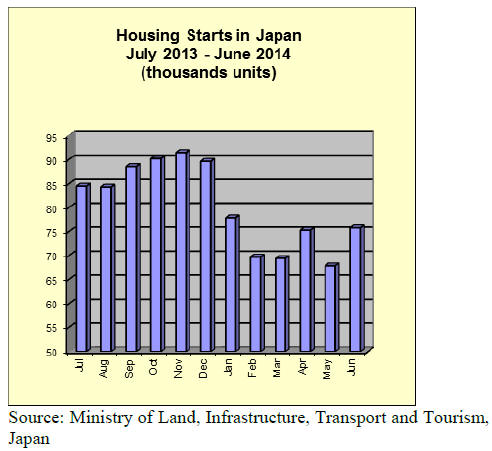
Yen strengthens and then swings down
At the beginning of the period reviewed, once again,
money moved to the „safe-haven‟ Japan in response to
uncertainty created by the downing of the Malaysia
aircraft over Ukraine, growing tension between the west
and Russia and the situation in Gaza.
However, the stronger yen was not sustained as traders
responded to a strengthening dollar. On the 25 July the US
dollar bought 101.86 yen, up from 101.3 a week earlier.
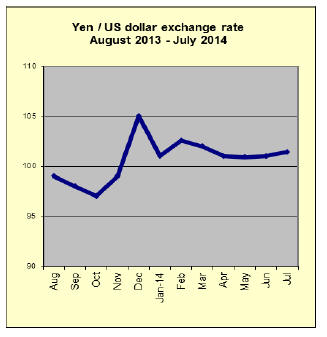
Trends in office, kitchen and bedroom furniture
imports
Japan‟s office, kitchen and bedroom furniture imports
from 2009 to the end of June 2014 are shown below.
Japan‟s imports of bedroom furniture continued down in
June marking the second monthly decline after the steep
rise seen in the months prior to the consumption tax rise in
April this year.
The demand for both office and kitchen furniture has
weakened and this is reflected in the flat import levels.
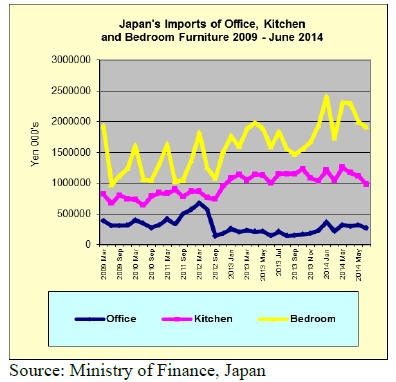
Office furniture imports (HS 9403.30)
China, Poland, Portugal and Italy provided around 85% of
all Japan‟s June imports of office furniture. Imports from
June imports from China were about the same as in May
while the value of imports for the others fell except for
Italy which expanded exports to Japan.
Overall, June imports of office furniture were down over
16%.
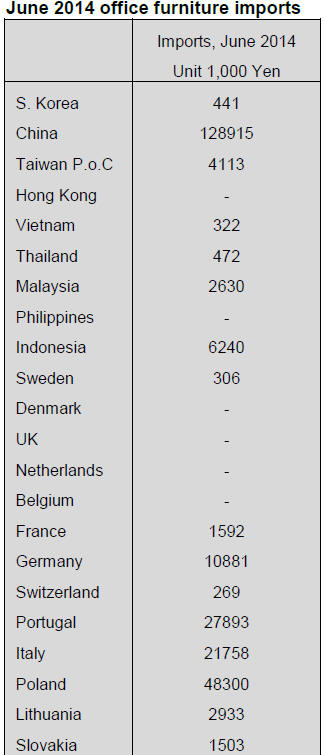 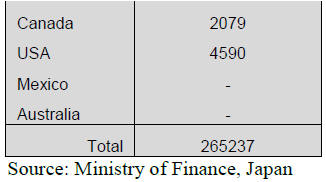
Kitchen furniture imports (HS 9403.40)
The top suppliers of kitchen furniture to Japan in June
remained Vietnam and China whcih together supplied
55% of imports. A further 26% was supplied by
Philippines and Indonesia.
In May Germany was a significant supplier of kitchen
furniture but in June exports to Japan fell.
Overall, there was a 12.5% decline in kitchen furniture
imports compared to a month earlier.
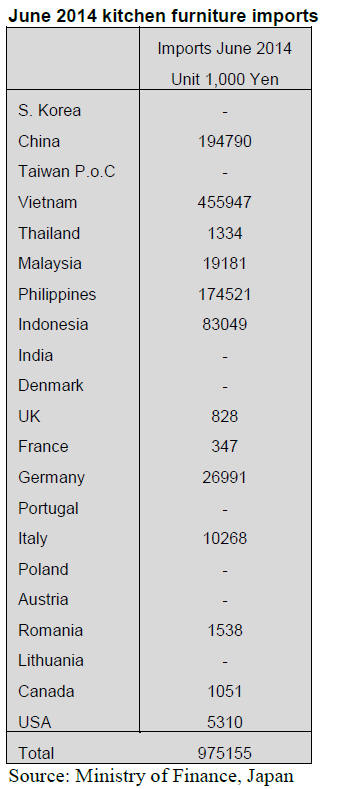
Bedroom furniture imports (HS 9403.50)
June bedroom furniture imports were marginally down on
May levels (-4%) with the top three of China, Vietnam and
Thailand accounting for the bulk of imports (80%).
Poland and Slovakia featured in the top ranked suppliers
but their combined contribution amounted to a little ove
5%.
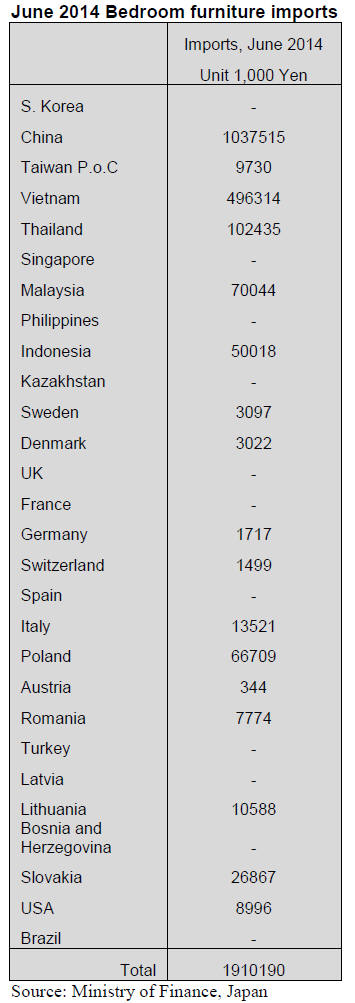
Trade news from the Japan Lumber Reports (JLR)
For the JLR report please see:
http://www.nmokuzai.
com/modules/general/index.php?id=7
Demand and supply of wood in 2013
The Forestry Agency (Japan) disclosed demand for wood
in 2013. Total demand was 73,867,000 cbms, 4.6% more
than 2012. That for lumber was 28,592,000 cbms, 9.7%
more and for plywood was 11,232,000 cbms, 9.1% more
while demand for pulp and wood chip was 30,353,000
cbms, 2.1% less.
The domestic supply was 21,117,000 cbms, 7.3% more
and the import was 52,750,000 cbms, 3.5% more. Growth
of domestic supply exceeded the imports so that the selfsufficiency
rate increased by 0.7 points to 28.6%.
Supply for lumber by import increased by 12.2%, which
surpassed domestic supply so that self-sufficiency rate was
down by 1.3 point to 42.2% while the domestic supply for
plywood and others grew more than the imports to make
self-sufficiency rate to 29.0%, 3.7 points up.
Both domestic and import supply for wood chip and pulp
declined with self-sufficiency rate of 17.1%. In this,
domestic log production was 20,818,000 cbms, 8.0% more
while supply of forest residue was 299,000 cbms, 25.6%
less. Obviously log supply for lumber and plywood was so
busy that removal of forest residue was way behind.
Sojitz plans sales expansion of Chinese poplar LVL
Sojitz Building Materials Corporation (Tokyo) will
expand sales of Chinese made poplar LVL. Poplar LVL is
one of strategic items of Sojitz.
Current monthly sales volume is 4,000-5,000 cbms then
target in 2017 is 10,000 cbms. About 3,000 cbms are for
fixture material and 1,000 cbms are for crating so far.
Sojitz started handling poplar LVL since 2004. Supply
sources are two plants of Taian Huihao Timber and
Huaian Hui Hao Timber of Hui Hao Timber group then
another plant of Jiangsu Fuqing Wood. They are in
Jiangsu and Shangdong province.
All those plants have acquired JAS certification for fixture
use and two plants have JAS certificate for structural use.
Products by Huaian Huihao plant are 100% for Japan
market with about 10 years‟ dealings with Sojitz. Sojitz
loaned about $750,000 for renewal of facility of Huaian
Hui Hao Timber.
Current market of poplar LVL is for stud for
condominium, core for interior fittings and crating. Sojitz
estimates it holds share of about 10% in Japan. Sojitz
plans to develop market for core of panel on top of current
market of stud, brace and ceiling joist.
Sojitz will aggressively propose use of LVL for builders
and precutting plants. In case they use light weight steel,
LVL can be replaced since LVL has cost competitiveness,
price stability, dimensional stability and short delivery
period.
Sojitz figures that the market of Chinese LVL will expand
to 600,000 cbms in 2017 as compared to current 440,000
cbms. It also considers capital investment on Chinese
plants if the market expands as much as it figures.
Basic order unit of sales is one container but it will market
small volume out of the inventory at major ports like
Osaka, Nagoya and Hakata.
Radiata pine logs and lumber
Movement of crating and pallet slowed down after rainy
season started in June. Up until April, crating lumber for
export cargoes and pallet moved well. Distribution was
busy and active before the consumption tax increased so
that orders on wood pallet was brisk then the orders
slowed down.
Crating lumber for export cargoes is not so active even
after the yen weakened. When the yen was strong many
industries moved manufacturing facilities to overseas
countries, which is why export business is not as busy as
before.
Order files of radiate pine log cutting sawmills dropped
down to several days but they maintain full operations.
Orvis closed down large mill then Tachikawa Forest
Products in New Zealand shut down so supply sources are
limited now. However, with weak demand, there is no
more chance to raise the lumber sales prices.
Plywood inventories on the rise
The market is weak after the demand started skidding
since May. Since late May, some wholesalers started
selling softwood plywood at low prices then in June some
manufacturers followed but the volume was small and
limited so that there was no sharp slide and the prices are
being held at 970-1,010 yen per sheet delivered on 12 mm
3x6.
While the manufacturers continued high level production,
the shipment started dropping sharply so that the inventory
started increasing much faster than the manufacturers
expected so that the manufacturers have started curtail the
production to hold the market prices.
Market of imported plywood is also slackening by
dropping demand and the market prices are under
downward pressure. Meantime, the supply side continues
bullish with high log prices. Order balance is decreasing
as the importers reduced the purchases but the supply side
figures the Japanese would come to buy sooner or later.
The market in Japan continues weak and dull. Wholesalers
and retailers make short coverings then the importers and
large dealers try to push more volume so that the prices are
weakening. Despite declining arrivals, port inventories
remain high because of slower shipments.
Current wholesale market prices of JAS 3x6 concrete
forming panel are 1,200-1,230 yen per sheet, 30 yen down
from June.
May plywood supply
Total supply of plywood in May was 546,700 cbms, 4.3%
less than May last year and 7% less than April. Import of
plywood declined in May, which reduced total supply than
April. Inventories of domestic softwood plywood
increased due to slower demand so the manufacturers
started production curtailment.
Imported volume in May was 308,600 cbms, 9.5% less
and 7.9% less. Monthly average for last five months is 317
M cbms, which is 1.9% less than the same period of last
year. Volume from Malaysia was133,300 cbms, 14,000
cbms less than April and 12.2% less and 9.7% less. Five
months average from Malaysia was 136,900 cbms, 8.5%
less than the same period of last year.
Indonesian volume was 87,300 cbms, 13.4% less and
3.2% less. Five months average from Indonesia was
90,500 cbms.
Chinese volume was 71,000 cbms, 6.8% less and 4% less.
June estimate of imports is 310 M cbms. Plywood import
from other sources other than major countries is increasing
so the monthly volume seems to stay about 300,000 cbms
for some time.
Future arrivals will decrease probably down to 270,000
cbms a month because orders for Malaysian mills have
been declining in last several months.
Domestic plywood production in May was 238,000 cbms,
3.6% more than May last year and 5.2% less than April. In
this, softwood plywood production was 221,800 cbms,
3.6% more and 6.2% less.
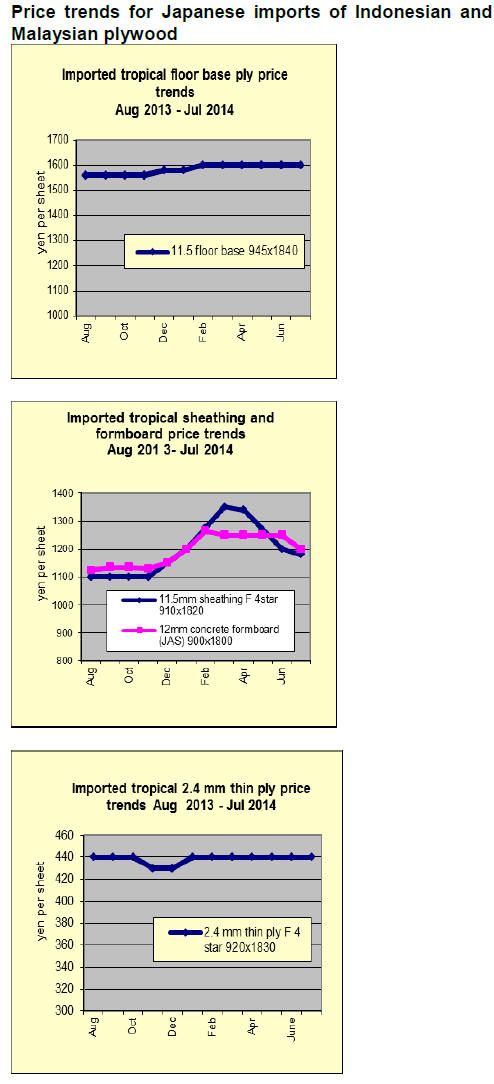
|